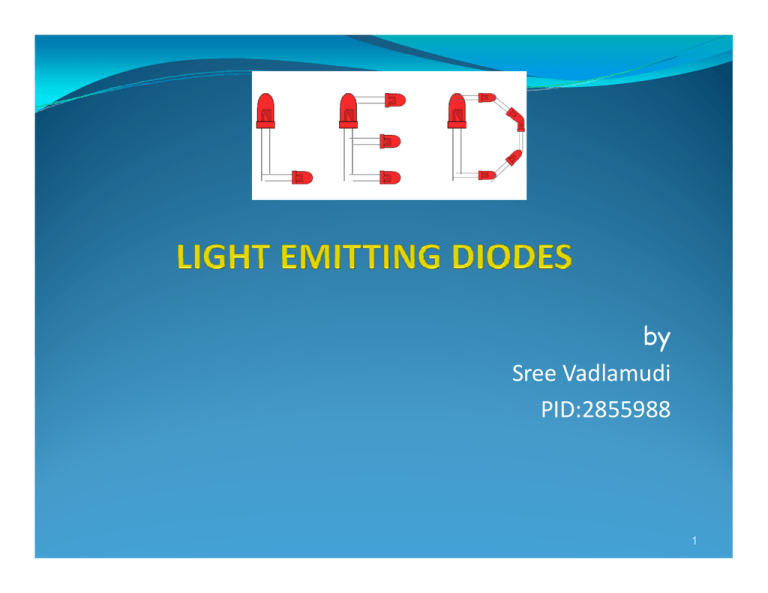LED
advertisement

by Sree Vadlamudi PID:2855988 1 A light emitting diode (LED) is essentially a PN junction opto‐ semiconductor that emits a monochromatic (single color) light when operated in a forward biased direction. LEDs convert electrical energy into light energy. They are frequently used as "pilot" lights in electronic appliances to indicate whether the circuit is closed or not. 2 About LEDs About LEDs The most important part of a light emitting diode (LED) is the semi‐ conductor chip located in the center of the bulb as shown at the right. The chip has two regions separated by a junction. 3 H How Does A LED Work? D A LED W k? When sufficient voltage is applied to the chip across the leads of the LED, electrons can move easily in only one direction across the junction between the p and n regions. In the p region there are many more positive than negative charges. When Wh a voltage lt i applied is li d and d the th currentt starts t t to t flow, fl electrons l t i the in th n region have sufficient energy to move across the junction into the p region. 4 How Does A LED Work? Electrical potential energy is converted into Electromagnetic energy . quantum of electromagnetic energy is emitted in the form of a photon of light with a frequency q y characteristic of the semi‐conductor material 5 Testing LEDs Never connect an LED directly to a battery or power supply! It will be destroyed almost instantly because too much current will pass through and burn it out. ! 6 Applications Sensor Applications Mobile Applications Mobile Applications Sign Applications Automative Uses LED Signals Illuminations Indicators I di 7 Sensor Applications Medical Instrumentation Bar Code Readers Color & Money Sensors Encoders Optical Switches Fiber Optic Communication 8 Mobile Applications Mobile Phone PDA's Digital Cameras Lap Tops General Backlighting 9 Sign Applications Full Color Video Monochrome Message Boards Traffic/VMS Transportation ‐ Passenger Information 10 Automative Applications Interior Lighting ‐ Instrument Panels & Switches, Courtesy Lighting Exterior Lighting ‐ CHMSL, Rear Stop/Turn/Tail Truck/Bus Lighting ‐ Retrofits, New Turn/Tail/Marker Lights 11 Signal Appications Traffic Rail Aviation Tower Lights Tower Lights Runway Lights Emergency/Police Vehicle Lighting LED ff LEDs offer enormous benefits over traditional incandescent lamps b fit t diti li d tl including: Energy savings (up to 85% less power than incandescent) gy g ( p p ) Reduction in maintenance costs Increased visibility in daylight and adverse weather conditions 12 Illumination Architectural Lighting Signage (Channel Letters) Machine Vision Retail Displays Emergency Lighting (Exit Signs) Neon Replacement Bulb Replacements Flashlights Outdoor Accent Lighting ‐ Pathway, Pathway Marker Lights 13 Illumination Use of LEDs in illumination applications can offer: offer Greater visual appeal Reduced energy costs Increased attention capture Savings in maintenance and lighting replacements As white LED technology continues to improve, the use of LEDs for general illumination applications will become more prevalent in the industry. 14 Indication Household appliances VCR/ DVD/ Stereo and other audio and video devices Toys/Games Instrumentation Security Equipment Switches 15 Colours of LEDs LEDs are made from gallium‐based crystals that contain one or more additional materials such as phosphorous to produce a distinct color. Different LED chip technologies emit light in specific regions of the visible light spectrum and produce different intensity levels. The colour of an LED is determined by the semiconductor material, not by the colouring of the 'package' (the plastic body). 16 Colours of LEDs Tri‐colour LEDs The most popular type of tri‐colour LED has a red and a green LED combined in one package with three leads. They are called tri‐colour because mixed red and green light appears to be yellow and this is produced when both the red and green LEDs are on. 17 Colours of LEDs Bi‐colour LEDs A bi‐colour LED has two LEDs wired in 'inverse parallel' (one forwards, one backwards) combined in one package with two leads. Only one of the LEDs can be lit at one time and they are less useful than the tri‐colour LEDs described above. 18 Comparison Of Chip Technologies For Wide‐Angle, Non‐ Diffused LEDs 19 LED Performance Luminous intensity (Iv) does not represent the total light output from an LED. Both the luminous intensity and the spatial radiation pattern (viewing angle) must be taken into account. If two LEDs have the same luminous intensity value, the lamp with the larger If two LEDs have the same luminous intensity value the lamp with the larger viewing angle will have the higher total light output. 20 What is an OLED? An OLED is an electronic device made by placing a series of organic thin films between two conductors. When electrical current is applied, a bright light is emitted. A device that is 100 to 500 nanometers thick or about 200 times smaller than a human hair. The OLED Structure Types of OLEDs Passive‐matrix Passive matrix Active‐matrix Passive Matrix Active Matrix 25 Advantages Thinner, lighter and more flexible Brighter Consume much less power Easier to produce and make into larger sizes Large field of view Large field of view references http://www.marktechopto.com/ http://acept.la.asu.edu/courses/phs110/expmts/exp13a.html http://www.kpsec.freeuk.com/components/led.htm htt // k f k / t /l d ht http://www.fiber‐optics.info/articles/LEDs.htm http://www.theledlight.com/technical1.html http://hyperphysics.phy‐astr.gsu.edu/hbase/electronic/leds.html htt //h h i h t d /hb / l t i /l d ht l www.kpsec.freeuk.com/components/led.htm 27 Thank you for your Th k f Attention!



